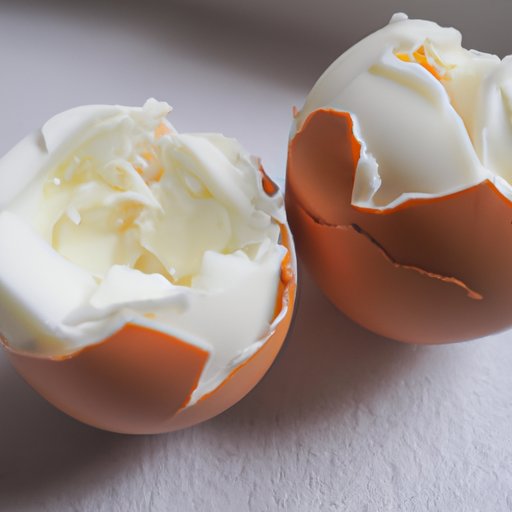
I. Introduction
If you’ve ever boiled eggs, you know the frustration of trying to peel them only to find chunks of egg white sticking to the shell. It seems like a minor issue, but it can turn a perfect breakfast into a frustrating mess. This article is designed to help you boil eggs for easy peeling, whether you’re making a quick morning snack or a fancy deviled egg appetizer. The tips and techniques outlined below are perfect for cooks of all levels, from beginners to experts.
II. Step-by-Step Guide
The first step to boiling eggs for easy peeling is selecting the right eggs. Avoid very fresh eggs, which are difficult to peel, and instead opt for eggs that are about a week old. They’ll be easier to peel and will still taste great. Once you have your eggs, place them in a single layer in a saucepan and add enough cold water to cover them by about an inch.
Place the pan on the stove over medium-high heat until the water comes to a rolling boil. Once it does, reduce the heat to low and let the eggs simmer for about 11 minutes. This will give you a perfectly hard-boiled egg with a creamy yellow center. If you prefer a soft-boiled egg, reduce the cooking time to six minutes.
Once your eggs are cooked, remove them from the heat and transfer them to a bowl of ice water. This will help stop the cooking process and make them easier to peel. After about five minutes, you can peel your eggs and enjoy them right away or store them in the refrigerator for later.
III. The Science Behind It
Eggshells are made up of both calcium carbonate and calcium phosphate. When eggs are stored in the refrigerator, the minerals in the shell start to break down. This makes them easier to peel after cooking. Additionally, eggs that are cooked longer or at a higher temperature can cause the protein in the egg white to stick to the shell. That’s why following the step-by-step guide outlined in Section II is essential to making eggs that are easy to peel.
Proper storage is also a crucial part of making easy-to-peel boiled eggs. Hard-boiled eggs should be refrigerated as soon as they cool down, since they can spoil quickly if left at room temperature. It’s also essential to store your eggs pointy-side down, as this will help to keep the yolks centered and prevent them from turning gray.
IV. Troubleshooting Tips
If you’re still having trouble with difficult-to-peel eggs, there are a few troubleshooting tips that might help. First, make sure your eggs are not too old or too fresh. Very fresh eggs can be challenging to peel, and very old eggs can develop air pockets that make them more prone to cracking during cooking. To test an egg’s freshness, you can place it in a bowl of water. If it sinks to the bottom and lays flat, it’s fresh. If it stands up on one end or floats, it’s not fresh.
Uneven cooking can also be a factor in difficult-to-peel eggs. Be sure to place them in a single layer in the saucepan, and avoid overcrowding, which can cause uneven cooking. If you’re cooking a large number of eggs, consider using a steamer basket instead of boiling them in water.
If you’re still having trouble peeling your eggs, try tapping them gently on a hard surface and rolling them gently to loosen the shell from the egg white. You can also try peeling them under cold running water, which can help to remove any bits of shell that stick to the egg white.
V. Timely Additions
Although it’s not essential, adding substances to the boiling water can also affect eggshell removal. For example, adding a teaspoon of baking soda to the water can make the eggshells easier to peel. This is because the baking soda increases the alkalinity of the water, which can help to break down the proteins in the egg white and make them less likely to stick to the shell.
Another substance you can try adding to the water is vinegar. The acid in the vinegar can help to dissolve any bits of the shell that might be sticking to the egg white. Finally, you can experiment with adding salt, soy sauce, or other seasonings to the water for a unique flavor.
VI. Perfect It
Boiling eggs for easy peeling is a skill, and like any skill, it takes practice to perfect. Here are a few tips to help you get there:
- Choose eggs that are about a week old.
- Cook the eggs for 11 minutes for a hard-boiled egg.
- Place the eggs in ice water after cooking to cool them quickly.
- Peel the eggs under cold running water to help remove any bits of shell that might be sticking to the egg white.
- Store the eggs pointy-side down in the refrigerator to help keep the yolks centered.
By following these tips and experimenting with different boiling times, water additives, and storage methods, you’ll soon be an expert at boiling eggs for easy peeling.
VII. Conclusion
In conclusion, boiling eggs for easy peeling is a straightforward process that anyone can master with a bit of practice. By following the step-by-step guide, troubleshooting tips, and suggestions for perfecting your technique, you’ll be able to enjoy perfectly boiled and easy-to-peel eggs every time.




